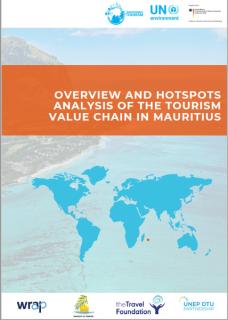
The Overview and Hotspots Analysis of the Tourism Value Chain in Mauritius assesses the environmental hotspots (areas of significant negative environmental impact) associated with the tourism sector in Mauritius.
The environmental hotspots identified for the tourism sector in Mauritius are broadly split between:
- Impacts relating to the production, transportation and consumption of food and beverage products (e.g. meat, fish and seafood and fresh produce production and shipment, food loss and waste, energy used in refrigeration, preparation and cooking of food);
- Impacts relating to the provision of services to the sector from other sectors of the economy (e.g. power generation and energy and water supply);
- Impacts arising from deficiencies in national infrastructure (e.g. the lack of recycling infrastructure, dated waste and water infrastructure which can lead to environmental pollution and preventable GHG emissions); and
- Impacts relating to the built environment in the tourism sector (e.g. hotel and restaurant energy use heating, ventilation and air conditioning lighting, preparation of food; water use in washing and sanitation, cleaning of rooms and public spaces; and for leisure activities, like swimming pools and spas).
In order to better understand the location and context for environmental hotspots during this analysis, the tourism value chain for the Dominican Republic was mapped to illustrate how the tourism sector operates, how it is supported by other sectors of the economy (e.g. energy and water supply infrastructure, building and construction, facilities management, food and beverage, transportation), how expenditure in the tourism sector is distributed in the economy and which value chain actors are able to control or influence the environmental hotspots identified during the analysis.
